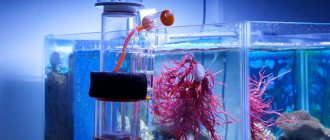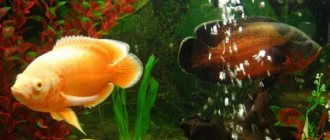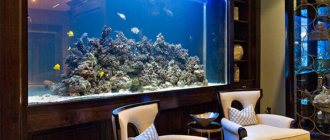An aquarium timer is a useful addition
connection to the rest of the equipment. Makes it possible to launch it in the absence of a person at a given time with a certain frequency. Using a timer, you can regulate the lighting on and off, the supply of oxygen and carbon dioxide.
Mechanical timers
Mechanical devices are relatively inexpensive and easy to set up. The simplest mechanical timer is a dial on which the closing and opening time of an electrical circuit is set.
A rather important circumstance is the presence of a special regulator that allows the electrical appliance connected to the timer to operate directly if necessary. This function can be useful when, for example, the program has turned off the light source, and we need to look at something in the aquarium.
The disadvantages of an electromechanical timer are the following:
- The same program for every day;
- When a power outage occurs, the time period of lack of power is not taken into account;
- Some models tick like alarm clocks, which can sometimes be annoying.
Electromechanical time relays are programmed in approximately the same way. Any mechanical timer has a scale for setting the time: usually the minimum interval is 15 minutes
Timer for an aquarium (do it yourself)
In the aquarium, certain parameters must always be maintained to ensure the favorable existence of the fish.
Indicators such as water temperature and lighting can be adjusted using photo relays and thermostats. But, to ensure the frequency of feeding the fish in the aquarium and saturating the water with oxygen using an aerator, a timer is required. In addition, a specially designed feeder is required to automatically accurately dose the amount of food in the aquarium. The kinematic diagram of the aquarium feeder is shown in Figure 1. The container into which a certain supply of food is poured is a pipe installed on a box-shaped base. In the opposite walls of this base, round holes are made along the diameter of the pipe - container. The holes are offset relative to each other by the value of the pipe's own diameter. Inside the box-shaped base with a minimum gap there is a feed dispenser (or die) capable of moving in the longitudinal direction. A hole is made in it according to the diameter of the container pipe. The thickness of the die (as well as the thickness of the internal space of the box-shaped base) is chosen so that the volume of the cylindrical container (chamber) formed by the hole in the dispenser is equal to the volume of a single portion of food - the daily norm for fish in the aquarium. The feeder works as follows. In the initial state, the dispenser is in the position shown in Fig. 1. That is, its chamber is located directly under the container for filling with food falling down. Now, if you set the die in motion according to the direction shown in Fig. 1 arrow, then the chamber filled with food will move to the left and will appear above the hole for food outlet, which is made in the lower wall of the box-shaped base, through which the contents of the chamber are poured into the aquarium. Then, the dispenser moves back and its now empty chamber is filled with food again. Thus, a kind of sluice system is obtained, in which the role of the sluice chamber is played by the camera in the dispenser. Now about the “related details” of the timer. To move the dispenser, an electromagnet with a lever - a pusher - is used. The position of the support is chosen so that the stroke of the lower end of the pusher is sufficient for the necessary movement of the die, during which the chamber in the dispenser moves from the hole under the container and becomes above the hole for the feed outlet. To return the die to its original position, after turning off the electromagnet, a return spring acts on compression. The schematic diagram of the timer is shown in Figure 2. The timer controls the feeder and aerator of the aquarium. The frequency of feeding fish in the aquarium is 24 hours, and the frequency of operation of the aerator is 2.5 hours. These parameters are set by “hard logic” and are not adjustable during operation. The timer is made using a digital circuit consisting of a clock multivibrator and a multi-bit binary counter. The clock generator frequency of 32768 Hz is stabilized by a clock quartz resonator Q1. Capacitors C1 and C2 serve to adjust the frequency of this multivibrator within small limits in order to calibrate the accuracy of the timer. Pulses from the output of the multivibrator on the D1 chip are supplied to a counter composed of three K561IE16 microcircuits. On the D3 chip there is a preliminary divider by 16384, at the output of which (pin 3) pulses are generated with a period of 0.5 seconds.
What follows is a circuit of counters D4 and D5 connected in series, the count of which is limited to 172800 by the “wiring OR” circuit on diodes VD3-VD7. This corresponds to 24 hours. That is, 24 hours after the start of work, a pulse appears on resistor R3, which sets all timer counters to zero. The same pulse sets the RS trigger D2.3-D2.4 to the single state. The high logic level from output D2.3 goes to the switch at VT1, which turns on relay K1. And this relay, in turn, supplies power to the electromagnet of the automatic feeder. After half a second, a unit appears at pin 9 D4, which returns the trigger to the zero position and, thereby, turns off the electromagnet of the feeder. This is repeated every 24 hours. To periodically turn on the aerator, the following pulses are used from pin 7 D5 with a period of about 2.5 hours. These pulses periodically open the key on VT2, and through K2 it turns on the power to the aerator. The aquarium timer circuit is powered from a universal source. A 12-14V DC source is connected to socket X1 (you can use a network adapter from an old printer or scanner). And the backup battery G1 serves in case of a power outage. In this case, only the microcircuits are powered from it, but not the relay windings. Diodes VD1 and VD2 separate the power circuits. It happens like this: in normal mode, the voltage on X1 comes from the source and is 12-14V, which is greater than the rated voltage of battery G1. Therefore, diode VD1 is closed, and VD2 is open and power comes only from the network source. If the network source of the timer is turned off (or the power supply is turned off), then the voltage on capacitors C3 and C4 begins to slowly fall and after some time becomes lower than the voltage G1. Diode VD2 closes, and VD1 opens and power supply to the microcircuits from G1 begins. Button S1 is used to reset the timer to the beginning of the countdown. It is recommended to press it after turning on the timer. And you need to turn on the timer at the time when the fish in the aquarium usually feed. After this, feeding will occur at exactly this time every day. The timer uses KUTS-1 relays from remote control systems of old domestic TVs as electromagnetic relays K1 and K2. You can use other relays with a 12V winding. The feeder electromagnet is made from the traction relay of the starter of a VAZ car. The electromagnet coil is rewound. All the old winding, made with thick wire, was removed, and instead of it, a new one was wound with thin PEV 0.12 wire until the frame was filled. The electromagnet is powered directly from the mains. When winding a coil, you need to, if not wind turn to turn, then at least evenly distribute the winding wire. The ends of the winding must be brought out from different sides of the frame and proper insulation must be ensured. The pusher lever and support can also be used from the same traction relay. The disadvantage of such an electromagnet is its large mass and excessive strength, as well as the need for rewinding. Therefore, it can be replaced with something more suitable, if possible. The base body is made of plywood, the dispenser is laminated chipboard, the tubular container can be made from a piece of plastic water pipe. All sizes depend on the volume of a single serving of food. Spring from starter traction relay.
AQUARIUM HEATER AND EVERYTHING YOU NEED TO KNOW ABOUT IT.
COMPRESSOR FOR AQUARIUM: DESCRIPTION, TYPES, PHOTO, VIDEO, TOP - 5.
HOW DO YOU CORRECTLY START AN AQUARIUM FOR THE FIRST TIME?
Electronic timers
The electronic timer can be programmed for any time period. These devices differ from each other only in design and some auxiliary functions: for example, the transition to winter and summer time or the motion response function. Any device has a switch that allows the connected electrical appliance to operate autonomously.
Electronic timer
An electronic timer has certain advantages compared to a mechanical one:
- You can set your own programs for each day;
- You can install one program for several days - for example, only for the first half of the week;
- Availability of rechargeable power supplies, allowing you to not depend on the mains when necessary;
- The device has no gears or other mechanical parts, so there is no alarm clock-like ticking.
As soon as power appears, the timer starts working again according to the set program. However, electronic time relays also have their drawbacks, and the main one is the relative fragility of rechargeable batteries. When the battery reaches the end of its service life, the timer can be discarded.
Smart aquarium
Using various aquarium maintenance devices, you can create a truly smart aquarium that will not require maintenance. Aquarium fish and plants, or rather, watching them, certainly provide aesthetic pleasure. But a real aquarist enjoys his own aquarium and fiddling with it, for example, replanting plants and cleaning water.
A complex smart aquarium is a complex engineering structure. The first step to a smart aquarium is to set a number of devices that serve it to work on a schedule. Do-it-yourself timers are designed specifically for this purpose.
Areas of application of timers
Timers independently turn on electrical or mechanical devices. For example, in the morning they turn on the lighting in the aquarium, and in the evening they turn it off. Ideally, the lighting in the aquarium should turn on when daylight fills the room and the fish wake up.
For these purposes, a time relay is indispensable. It will help to turn on the light in the mornings on winter days, when it is late in the morning and the owners have long gone to work, as well as in the evenings, if, for example, they have stayed too long at a party. An electronic timer will turn on the lights in the aquarium for several days when the owners are away from home.
Operation of the device greatly simplifies the maintenance of the aquarium. Inhabitants of the underwater world, including plants, quickly adapt to cyclical time processes: the timer relieves your pets of unnecessary stress. The time relay also turns on the compressor at the time you need. In aquariums that require 24/7 aeration using multiple compressors, the timer can be programmed to allow one or the other air supply to rest.
Thermostats can also be automated: these devices can be given a rest at night. You can connect an aquarium pump to the time relay, which is necessary for gradually changing the water in the aquarium.
HOW TO CHOOSE LAMPS AND TIMERS FOR AUTOMATIC LIGHTING IN AQUARIUM
FSB
0
10 795
Share
You are forever responsible for those you put in the aquarium. Let us slightly paraphrase the famous phrase of Saint-Exupery and note that the first problem is to create the most optimal conditions for the life and prosperity of plants and fish.
And one of the main tasks is to organize proper lighting. Photosynthesis and regulation of basic life processes are impossible without sufficient quantity (and, looking ahead, quality) of light. In addition, the correct lighting will help you to admire a full-color picture of what is happening in your home water kingdom at any time.
Correct spectrum and color rendition
A common truth: aquatic plants need to receive light not just in sufficient quantity, but of a certain quality and parameters that accelerate the process of photosynthesis.
In natural bodies of water, the amount of light depends on many situational factors: depth, water composition, angle of incidence of sunlight and their intensity. When buying lamps for an aquarium, we take on the functions of nature. Therefore, study in advance what is good for aquatic inhabitants and what is not so good. Our task is to bring artificial lighting as close as possible to natural lighting, which is possible with the right combination of two characteristics:
- optimal spectral composition;
- high color accuracy.
Let's look at them in more detail.
Spectrum composition
To ensure the normal functioning of aquatic plants, the entire visible spectrum of light is necessary. But for most, two spectral ranges are especially important - red and blue-green. Therefore, you should choose lamps whose spectral composition increases the intensity of these particular zones.
Color Rendering (CRI)
An important parameter that shows the accuracy with which the light bulb conveys the real, natural shades of the objects it illuminates. Ideal CRI = 100 Ra, this is an indicator of sunlight. For installation in an aquarium, look for models with a value of 75 Ra - the higher, the more attractive the underwater garden will look.
Are LED bulbs suitable?
Of all the varieties existing on the market, they are at the peak of popularity: economical, environmentally friendly, low heating and durable (manufacturers declare up to 30-50 thousand hours). In addition, prices for LED products are gradually becoming more affordable. Long tubular models mounted under a lid are functionally suitable for an aquarium, and there are plenty of these among the LED range, in any format. But are they suitable for lighting?
As a consultant specializing in the sale of lighting equipment told us, LED lamps are not the most suitable option. The catch is in technology.
With all the undeniable advantages of LEDs, only in the production of fluorescent lamps is it possible to provide the glow of the spectrum shades desired by the inhabitants of the aquatic world, filtering out the unsuitable ones.
So as not to rack your brains
Leading manufacturers of lighting products (for example, Philips or Osram) have long patented special phosphor paints, which are used in the manufacture of special series of lamps for aquarium plants. Thus, the Osram brand has a well-established Fluora line. These are special lamps for aquariums - linear, with a glass bulb, a high color rendering index (over 75 Ra), with a G13 base, power from 18 W and various lengths (from 590 mm). The use of such series helps improve the processes of photosynthesis and photomorphogenesis, since their light is most favorable for plants.
What, how many, where to install
How many light bulbs should I use? It depends on the power. You will need to make a simple calculation based on the recommendations:
- Illumination level up to 0.5 W/liter is low (but suitable for shade-loving fish and a limited number of plant species, including Cryptocoryne cordata, fern Bolbitis gedeloti, Java moss);
- 1 W/liter is excessive (although it is appropriate for container heights of more than 0.7 m and high plant saturation, so everything is individual);
- To be on the safe side, focus on a figure of about 0.7 W/liter; this will be optimal for most representatives of the underwater world.
Let's look at the example of the above-mentioned Fluora series. Thus, the light from a 58 W T8 58/77 G13 fluorescent lamp is sufficient for a capacity of 80 liters:
58 / 0.7 = 82.8 liters,
and a 36 W model from the same series is capable of illuminating a 50-liter aquarium:
36 / 0.7 = 51.4 liters.
But for a 100-liter one you will need 2 pieces. But there is an important nuance here.
Expert advice: for a large volume it is better to try a combination - a special aquarium lamp like Fluora from Osram plus a cool white LED. Mixed lighting will allow you to achieve more attractive and natural shades. It’s convenient to pick up both T8 lamps here.
For example, for a 100-liter aquarium, you can combine the above-mentioned special 58 W lamp and “get” the remaining watts with a 14-15 W LED option. For the brightest and most natural illumination, a color temperature of about 6500 K (daylight white light, close to midday sunlight) is suitable.
If you install a lamp with higher brightness and a high color rendering coefficient closer to the front wall, the backlight will be more visually pleasing, and the picture of the underwater world will be brighter and more realistic.
Length of daylight
This is an individual parameter and depends on the type of fish and plants and their preferences. But we can still talk about general recommendations.
The optimal light regime for an aquarium is 8-12 hours of intense light, followed by rest time. The fact is that for most plants, 6 hours of bright light period is enough for successful photosynthesis. This is enough for the carbon dioxide in the water to be converted into organic substances necessary for further growth and development. Then the activity decreases, and everything that is not absorbed is easily consumed by the algae. Therefore, an excessive period of bright light can cause an unwanted algal outbreak.
Please note that the minimum phase of continuous lighting should be 4 hours so that the plants have time to react to it.
"On-off" using a timer
We’ve sorted out the mode of activity and rest, now it’s time to move on to the question of how to ensure a stable lighting mode. Turn it on and off manually? Not an option, because you need to observe cycles, and we all have things to do besides serving aquatic pets.
It’s easy to automate the process of changing day and night for your favorite fish using a timer. With modern devices, you can easily set up a lighting cycle and stop worrying about maintaining it. Especially if you choose easy-to-use socket models. You just connect the backlight through such a timer, set the operating periods - and that’s it, the system is autonomous.
Which timer should I choose?
There are two main groups: electronic and mechanical.
Mechanically reliable, simple in design, affordable. And electronic ones are more convenient and functional for many tasks. The choice depends on personal preference. But most water garden lovers agree on one thing - it’s better to trust lighting automation to devices from proven, reliable brands that are responsible for quality.
Thus, according to our consultant, timers from the German manufacturer Theben are in great demand among those who equip an aquarium. Among the undisputed hits are the rosette mechanical Timer 26 with a daily program and the electronic weekly Eltimo 020S with a display. Both options are easy to use and reliable, just follow the instructions in the instructions. These and other timers on the electrical engineering website can be compared with each other in all respects.
Aesthetics plus the health of aquatic pets - it's not difficult
Here, perhaps, are all the main points that are worth considering when organizing lighting. Pay attention to the characteristics of the light bulbs, think about their placement, automate the lighting cycles and enjoy the fruits of your activity, looking at beautifully lit, healthy, full-colored plants and colorful, happy fish.
And remember that it wouldn’t hurt to consult with a specialist, especially since no one in the modern world has taken money for this for a long time.
Dmitry Vaskevich with information support from the electrical engineering company AxiomPlus
Tags: aquarium lamps, timer, daylight hours, spectrum, color rendition
Found an error or a dead link?
Select the problematic fragment with the mouse and press CTRL+ENTER. In the window that appears, describe the problem and send it to the resource Administration.
Tips and warnings
Do not connect devices to the timer that consume more power than permitted.
Heaters and filters should not be connected to the timer. Turning the heater on and off is usually controlled by a water temperature sensor, and the filtration process must be continuous, and filters that are turned off usually cannot be left immersed in water.
You should not connect several devices to one timer. It is better to use separate timers for each device or use a multi-channel timer.











